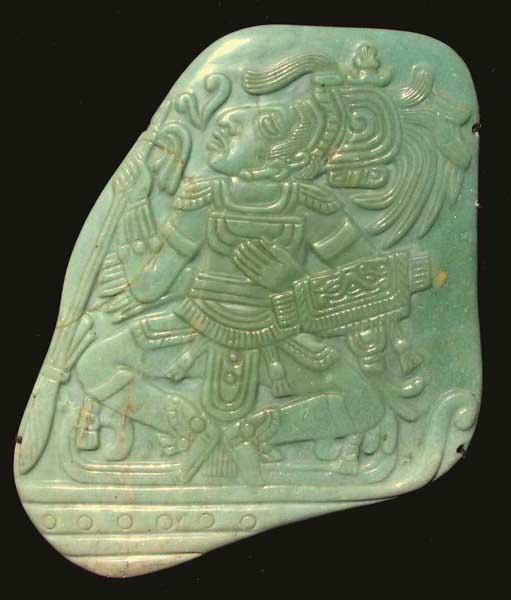 |
usa | world | animals | vocabulary | health | science | math | history |
The Maya
The Maya are people of southern Mexico and northern Central America (Guatemala, Belize, western Honduras, and El Salvador) with some 3,000 years of history. The Maya were part of the Mesoamerican Pre-Columbian cultures. Contrary to popular myth, the Maya people never "disappeared." Millions still live in the region, and many of them still speak one of the Maya family of languages.
Archaeological evidence shows the Maya started to build ceremonial architecture approximately 3000 years ago. There is some disagreement about the borders and difference between the early Maya and their neighboring Pre-Classic Mesoamerican civilization, the Olmec culture. The Olmec and early Maya seem to have influenced each other.

The earliest monuments consist of simple burial mounds, the precursors to pyramids erected in later times. Eventually, the Olmec culture faded after spreading its influence into the Yucatan peninsula, present-day Guatemala, and other regions.
The Maya developed the famed cities of Tikal, Palenque, Copán and Kalakmul, as well as Dos Pilas, Uaxactun, Altun Ha, Bonampak and many other sites in the area. They developed an agriculturally intensive, city-centered empire consisting of numerous independent city-states. The most notable monuments are the pyramids they built in their religious centers and the accompanying palaces of their rulers. Other important archaeological remains include the carved stone slabs usually called stelae (the Maya called them Tetun, or "Tree-stones"), which depict rulers along with hieroglyphic texts describing their genealogy, war victories, and other accomplishments. The Maya participated in long distance trade in Mesoamerica and possibly further lands. Important trade goods included cacao, salt, and obsidian.
Many consider Maya art of their Classic Era (c. 200 to 900 a.d.) to be the most sophisticated and beautiful of the ancient New World. The carvings and stucco reliefs at Palenque and the statuary of Copán are especially fine, showing a grace and accurate observation of the human form that reminded early archaeologists of Classical civilization of the Old World, hence the name bestowed on this era. We have only hints of the advanced painting of the classic Maya; mostly what have survived are funerary pottery and other Maya ceramics. Also a building at Bonampak holds ancient murals that survived by serendipity. With the decipherment of the Maya script it was discovered that the Maya were one of the few civilizations where artists attached their name to their work.

As unique and spectacular as any Greek or Roman architecture, Maya architecture spans many thousands of years; yet, often the most dramatic and easily recognizable as Maya are the fantastic stepped pyramids from the Terminal Pre-classic period and beyond. These pyramids relied on intricate carved stone in order to create a stair-step design. Each pyramid was dedicated to a deity whose shrine sat at its peak. During this "height" of Maya culture, the centers of their religious, commercial and bureaucratic power grew into incredible cities, including Chichen Itza, Tikal, and Uxmal. Through observation of the numerous consistent elements and stylistic distinctions, remnants of Maya architecture have become an important key to understanding the evolution of their ancient civilization.
In the 8th and 9th centuries AD Classic Maya culture went into decline, with most of the cities of the central lowlands abandoned. Warfare, ecological depletion of croplands, and drought or some combination of those factors are usually suggested as reasons for the decline. There is archaeological evidence of warfare, famine, and revolt against the elite at various central lowlands sites.
The Maya cities of the northern lowlands in Yucatan continued to flourish for centuries more; some of the important sites in this era were Chichen Itza, Uxmal, Edzná, and Coba. After the decline of the ruling dynasties of Chichen and Uxmal, Mayapan ruled all of Yucatan until a revolt in 1450; the area then devolved to city states until the Spanish Conquest.
The Itza Maya, Kowoj and Yalain groups of Central Peten survived the "Classic Period Collapse" in small numbers and by A.D. 1250 reconstituted themselves to form competing polities. The Itza kingdom had its capital at Noj Peten, an archaeological site thought to underlay modern day Flores, Guatemala. It ruled over a polity extending across the Peten Lakes region, encompassing the community of Eckixil on Lake Quexil. These sites and this region were inhabited continuously by independent Maya until after the final Spanish Conquest of A.D. 1697.
Post-Classic Maya states also continued to thrive in the southern highlands. One of the Maya kingdoms in this area, the Quiché, is responsible for the best-known Mayan work of historiography and mythology, the Popol Vuh.

The Spanish started their conquest of the Maya lands in the 1520s. Some Maya states offered long fierce resistance; the last Maya state, the Itza kingdom, was not subdued by Spanish authorities until 1697.
The Spanish American Colonies were largely cut off from the outside world, and the ruins of the great ancient cities were little known except to locals. In 1839 however, American traveler, John Lloyd Stephens, hearing reports of lost ruins in the jungle, visited Copán, Palenque, and other sites with English architect and draftsman Frederick Catherwood. Their illustrated accounts of the ruins sparked strong interest in the region and the people, and they have once again regained their position as a vital link in Mesoamerican heritage.
Much of the contemporary rural population of Guatemala and Belize is Maya by descent and primary language; a Maya culture still exists in rural Mexico.
This article is licensed under the GNU Free Documentation License. It uses material from the Wikipedia article "Maya".